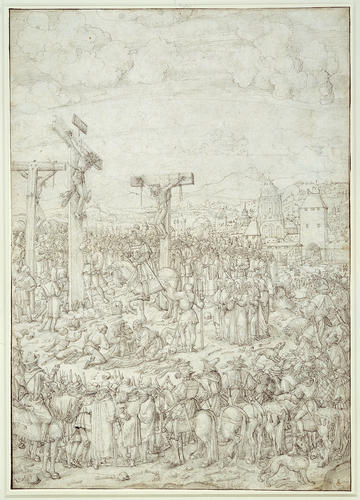The Crucifixion dated 1533
Pen and ink | 55.5 x 39.4 cm (sheet of paper) | RCIN 912172
-
A large drawing of a Crucifixion scene with Christ and the two thieves on their crosses, surrounded by many figures in the landscape.
Augustin Hirschvogel was born in Nuremberg, the son and pupil of the city's leading glass painter Veit Hirschvogel the Elder. Nuremberg's acceptance in 1525 of the Reformation, generally hostile to religious imagery, must have reduced the demand for pictorial stained glass, and in 1536 Hirschvogel left for Ljubljana, broadening his interests into cartography, mathematics and etching. He eventually settled in Vienna, where he spent the last ten years of his life.
This large drawing of the Crucifixion was dated by the artist 1533, towards the end of his time in Nuremberg. The adjacent monogram LC is in a different ink and was no doubt added by a later owner who wished the artist to be Lucas Cranach (1472-1553). Several elements of the composition relate, in conception if not in detail, to those in a smaller drawing by Hirschvogel of Christ on the Cross and the Brazen Serpent in the British Museum - the angle from which Christ is seen, the huddle of holy figures at centre right, the horseman, and the soldiers throwing dice for Christ's clothes. The British Museum sheet is one of seven by Hirschvogel illustrating thematic parallels between the Old and New Testaments, which seem to be models for illuminations by Nikolaus Glockendon (d.1534) in a prayer book executed in Nuremberg for Cardinal Albrecht of Brandenberg (now Modena, Biblioteca Estense). The function of the present drawing is, however, uncertain. Its unusual size, the uneven framing line added by the artist (visible just inside the later black mount line), and the inscribed date all suggest that it was intended as a finished piece, but the small scale of the figures and their rather uniform detailing would make it hard to read from any distance if framed and hung.
An inscription on the reverse of the sheet, recording the date of 26 August 1654, is of a type associated with the painter Jan Baptist Weenix (1610-66). At that time Weenix was living in Utrecht, where he served as the agent for the art collector Willem Vincent, Baron von Wittenhorst, and he presumably acquired the drawing on that date either for his own collection or for the Baron. The date of entry of the drawing into the Royal Collection is unknown.
Dated lower right 1533, a monogram LC added later; inscribed on the verso Den 26. Augusti 1654
Text adapted from Holbein to Hockney: Drawings from the Royal CollectionProvenance
Probably acquired by J.B. Weenix, 1654; perhaps Willem Vincent, Baron van Wittenhorst; Royal Collection by c. 1810
-
Creator(s)
(collector) -
Medium and techniques
Pen and ink
Measurements
55.5 x 39.4 cm (sheet of paper)
Other number(s)
RL 12172









